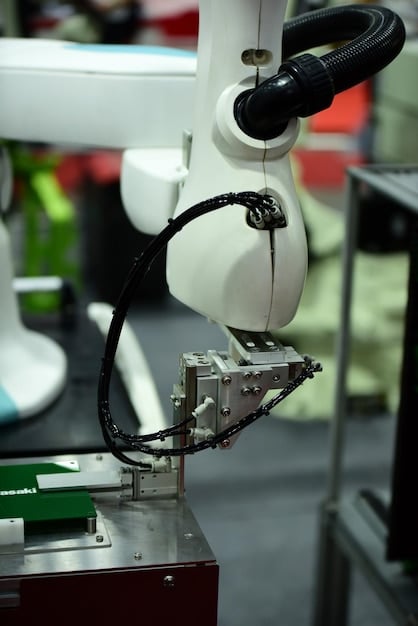Sustainable Auto Materials: How US Manufacturers Are Adapting

US auto manufacturers are adapting to the growing demand for sustainable materials in vehicle production by investing in research and development, forming strategic partnerships, and implementing new manufacturing techniques to incorporate materials such as recycled plastics, bio-based composites, and sustainable metals.
The automotive industry is undergoing a significant transformation, driven by increasing consumer demand for environmentally friendly vehicles and stricter regulations aimed at reducing carbon emissions. A key aspect of this shift is the adoption of sustainable materials in vehicle production. But how are US auto manufacturers adapting to the growing demand for sustainable materials in vehicle production? Let’s delve into the strategies and innovations shaping this crucial evolution.
The Push for Sustainable Materials in Auto Manufacturing
The automotive industry has long been associated with environmental concerns, from emissions to waste generation. However, growing awareness among consumers and regulatory pressures are compelling manufacturers to rethink their approach. Sustainability is no longer a niche concept but a core business imperative.
The demand for sustainable materials in auto manufacturing is driven by several factors, including:
Consumer Preferences
More and more consumers are actively seeking eco-friendly products, including vehicles. They are willing to pay a premium for cars made with sustainable materials, reflecting a shift in values and priorities.
Regulatory Requirements
Governments around the world are implementing stricter regulations to reduce carbon emissions and promote sustainability in the automotive sector. These regulations often mandate the use of recycled or bio-based materials.
Environmental Concerns
The environmental impact of traditional auto manufacturing is significant, from the extraction of raw materials to the disposal of end-of-life vehicles. Using sustainable materials helps reduce this impact and promotes a circular economy.
To meet these demands, US auto manufacturers are exploring a range of sustainable materials and innovative production techniques.

Innovative Materials Transforming Vehicle Production
The quest for sustainability has led to the development and adoption of a diverse range of innovative materials in vehicle production. These materials offer a combination of environmental benefits, performance improvements, and cost-effectiveness.
Some of the most promising sustainable materials include:
Recycled Plastics
Recycled plastics are derived from post-consumer or post-industrial waste. They can be used to manufacture a variety of automotive components, including interior panels, bumpers, and under-the-hood parts.
Bio-Based Composites
Bio-based composites are made from natural fibers such as hemp, flax, and kenaf, combined with bio-based resins. These materials are lightweight, strong, and biodegradable, making them ideal for interior components and body panels.
Sustainable Metals
Sustainable metals include recycled aluminum and steel, as well as metals produced using environmentally friendly processes. These materials offer excellent strength and durability while reducing the environmental footprint of vehicle production.
- Lightweighting: Sustainable materials often contribute to reducing the overall weight of vehicles, improving fuel efficiency and reducing emissions.
- Durability: Many sustainable materials offer excellent strength and durability, ensuring the longevity of automotive components.
- Aesthetics: Sustainable materials can be designed to meet the aesthetic requirements of modern vehicles, offering a range of colors, textures, and finishes.
These innovative materials are not only environmentally friendly but also offer performance advantages that make them attractive to auto manufacturers.
Strategies US Manufacturers Are Employing
US auto manufacturers are implementing a variety of strategies to integrate sustainable materials into their vehicle production processes. These strategies range from investing in research and development to forming strategic partnerships and adopting new manufacturing techniques.
Key strategies include:
Research and Development
Manufacturers are investing heavily in R&D to explore new sustainable materials and improve the performance and cost-effectiveness of existing ones. This includes partnerships with universities and research institutions.
Supply Chain Collaboration
Building a sustainable supply chain is crucial for ensuring the availability and quality of sustainable materials. Manufacturers are working closely with suppliers to develop and implement sustainable sourcing practices.
Manufacturing Process Innovation
Integrating sustainable materials often requires changes to existing manufacturing processes. Manufacturers are investing in new equipment and techniques to efficiently and effectively incorporate these materials into vehicle production.
By combining these strategies, US auto manufacturers are making significant progress in adopting sustainable materials and reducing the environmental impact of their operations.

Challenges and Opportunities in Transitioning to Green
While the transition to sustainable materials offers numerous benefits, it also presents several challenges for US auto manufacturers. Overcoming these challenges is essential for achieving long-term success in the green automotive market.
Key challenges include:
Cost Competitiveness
Sustainable materials can sometimes be more expensive than traditional materials, which can impact the cost competitiveness of vehicles. Manufacturers need to find ways to reduce the cost of sustainable materials through economies of scale and technological innovation.
Performance Trade-offs
Some sustainable materials may not offer the same level of performance as traditional materials in certain applications. Manufacturers need to carefully evaluate the performance characteristics of sustainable materials and address any potential trade-offs.
Supply Chain Complexity
Building a sustainable supply chain can be complex and challenging, requiring close collaboration with suppliers and adherence to strict environmental and social standards. Manufacturers need to invest in robust supply chain management systems to ensure the integrity of their sustainable sourcing practices.
Despite these challenges, the opportunities for US auto manufacturers in the green automotive market are significant. By embracing sustainability, manufacturers can enhance their brand image, attract new customers, and contribute to a more sustainable future.
The Role of Policy and Regulation
Government policies and regulations play a crucial role in driving the adoption of sustainable materials in the automotive industry. These policies can create incentives for manufacturers to invest in sustainability and level the playing field for sustainable materials.
Incentives and Subsidies
Governments can offer financial incentives, such as tax credits and subsidies, to encourage manufacturers to use sustainable materials. These incentives can help offset the cost of sustainable materials and make them more attractive.
Mandates and Standards
Governments can also set mandates and standards for the use of recycled or bio-based materials in vehicles. These mandates can create a guaranteed market for sustainable materials and drive innovation in the industry.
Extended Producer Responsibility
Extended producer responsibility (EPR) schemes hold manufacturers responsible for the end-of-life management of their products. This can incentivize manufacturers to design vehicles for recyclability and use sustainable materials.
By implementing effective policies and regulations, governments can accelerate the transition to sustainable materials in the automotive industry and promote a more circular economy.
Future Trends in Sustainable Auto Materials
The future of sustainable auto materials is bright, with ongoing research and development efforts paving the way for even more innovative and environmentally friendly materials. Several key trends are expected to shape the industry in the coming years.
Nanomaterials
Nanomaterials offer unique properties that can enhance the performance and durability of sustainable materials. They can be used to create lightweight composites, improve the strength of recycled plastics, and enhance the corrosion resistance of metals.
Self-Healing Materials
Self-healing materials can repair damage automatically, extending the lifespan of automotive components and reducing waste. These materials are particularly promising for exterior panels and coatings.
3D Printing
3D printing, also known as additive manufacturing, allows for the creation of complex and customized automotive components using sustainable materials. This technology can reduce waste, improve design flexibility, and enable the production of lightweight parts.
- Advanced Composites: The development of advanced composites that combine strength, lightweighting, and recyclability.
- Smart Materials: The integration of smart materials that can adapt to changing conditions, such as temperature and stress.
- Bioplastics: The increased use of bioplastics derived from renewable resources, such as corn and sugarcane.
These future trends promise to further revolutionize the automotive industry and drive the adoption of sustainable materials on a global scale. The automotive industry is actively exploring and trying to figure out how are US auto manufacturers adapting to the growing demand for sustainable materials in vehicle production?
| Key Point | Brief Description |
|---|---|
| 🌱 Sustainable Materials | Use of recycled plastics, bio-based composites, and sustainable metals. |
| 🤝 Supply Chain | Collaborating with suppliers for sustainable sourcing. |
| 💰 Incentives | Government policies and regulations. |
| 🚀 Future Trends | Exploring nanomaterials, self-healing components, and 3D printing. |
Frequently Asked Questions
▼
Sustainable materials include recycled plastics, bio-based composites (hemp, flax), sustainable metals (recycled aluminum, steel), and other eco-friendly alternatives that reduce the environmental impact of vehicle manufacturing.
▼
Manufacturers are using these materials due to growing consumer demand for eco-friendly vehicles, stricter environmental regulations, and the need to reduce the carbon footprint associated with traditional auto production.
▼
Recycled plastics reduce waste, lower the demand for new resources, and can be used in various components like interior panels and bumpers, making vehicles more sustainable and cost-effective.
▼
Government incentives like tax credits, subsidies, mandates for recycled content, and extended producer responsibility (EPR) schemes encourage manufacturers to adopt sustainable practices and materials.
▼
Future trends include the use of nanomaterials, self-healing materials, 3D printing for customized parts, advanced composites, smart materials that adapt to conditions, and increased adoption of bioplastics from renewable resources.
Conclusion
Adapting to the rising demand for sustainable materials is crucial for US auto manufacturers seeking long-term success. By embracing innovation, forming strategic partnerships, and leveraging supportive policies, they can drive the transition to a more sustainable and environmentally responsible automotive industry.





